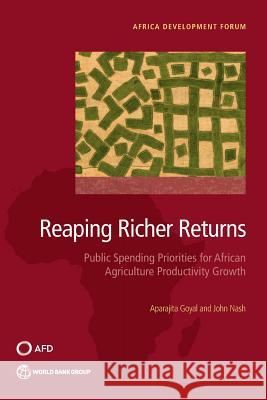Reaping Richer Returns: Public Spending Priorities for African Agriculture Productivity Growth » książka
Reaping Richer Returns: Public Spending Priorities for African Agriculture Productivity Growth
ISBN-13: 9781464809378 / Angielski / Miękka / 2017 / 250 str.
Reaping Richer Returns: Public Spending Priorities for African Agriculture Productivity Growth
ISBN-13: 9781464809378 / Angielski / Miękka / 2017 / 250 str.
(netto: 156,33 VAT: 5%)
Najniższa cena z 30 dni: 154,50
ok. 30 dni roboczych
Dostawa w 2026 r.
Darmowa dostawa!
Experience has shown that governments choices on spending of public resources makes a great deal of difference in agricultural sector development. Agricultural public spending in Africa not only lags behind other developing regions by several metrics of volume, its impact is also vitiated by misinvestment such as subsidies and transfers that tend to benefit the better off, with insignificant gains for the poor. Shortcomings of the budgeting process also reduce spending effectiveness. African governments and regional institutions such as NEPAD and the CAADP have clearly recognized the importance of enhancing the quantity and quality of spending in the sector, and are working hard to assist countries in meeting these objectives. This volume is intended to support these efforts, and is the first to pull together evidence on spending policy in such a comprehensive manner. The volume (i) takes stock of the current state of knowledge and generates new research to look at the effectiveness of different types of spending, and to draw conclusions about what works, what doesn t, and why; (ii) provides evidence-based guidance and pragmatic policy advice to governments, development partners, civil society, and the private sector on the cost-effectiveness of major kinds of programs, and their collateral consequences; (iii) identifies common problems that impede spending effectiveness, whether in the realm of political economy or more technical in nature, and examines how these can be overcome. Downsizing and re-designing ineffective subsidy programs, and integrating them in more holistic programs of investments, would be a more effective way to improve productivity. This would also give more scope for increasing spending on some other public goods and services that are likely to provide very high returns for agriculture and are currently greatly under-resourced, including research, land governance, and various kinds of hard and soft infrastructure. Forces of political economy often tend to militate against good spending choices, favoring short-gestation and high-visibility projects over others that offer much higher rewards over a longer time horizon. But actions to generate and disseminate knowledge on the impacts of alternative spending options among all interested groups (e.g., through more and better impact evaluations), and then enhance their capacity to affect change, can help counteract these tendencies"











